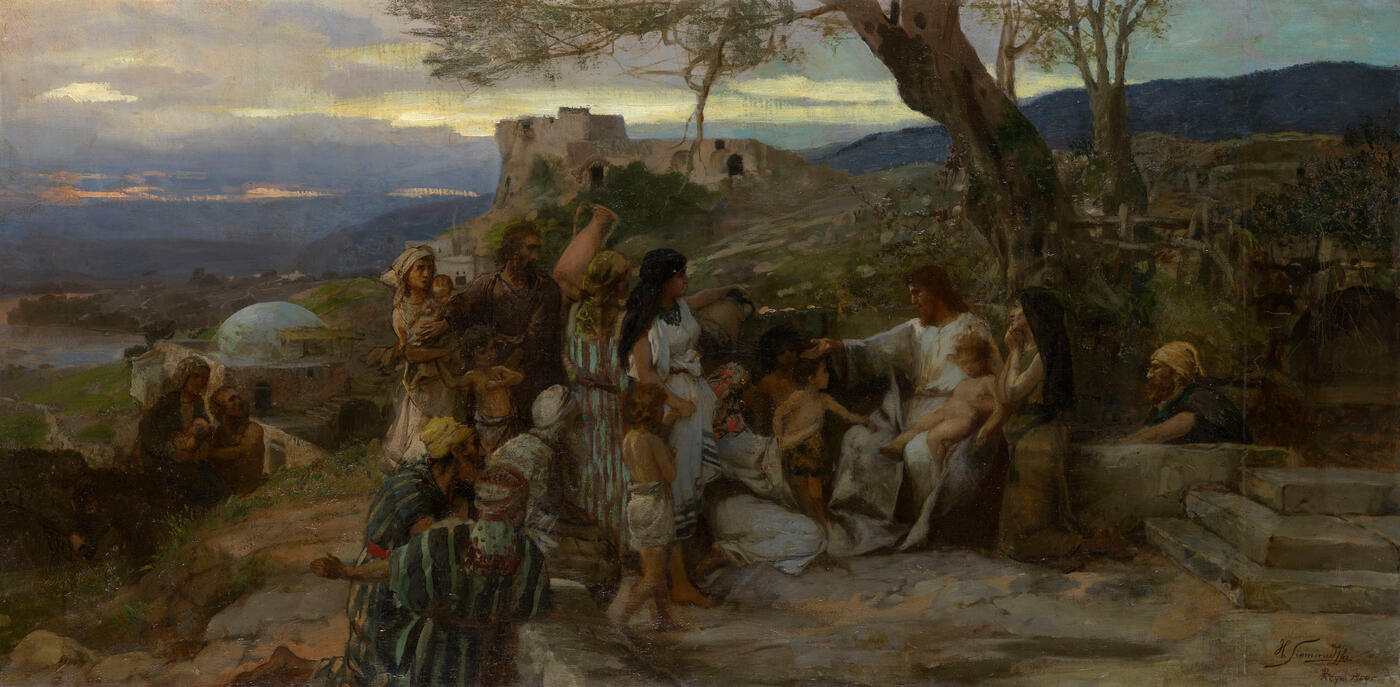25 - 28 November 2012 Russian Art Auctions
25 November 2012

2. SEMIRADSKY, GENRIKH (1843–1902)
Christ Blessing the Children, signed, inscribed 'Rzym' and dated 1900.
Oil on canvas, laid on canvas, 54.5 by 111 cm.
400,000–600,000 GBP
Provenance: Collection of the artist’s widow Maria Semiradskaya.
Private collection, Europe.
Authenticity of the work has been confirmed by the artist’s son Leon Siemiradzki (label on the reverse).
Authenticity has also been confirmed by the expert T. Karpova.
Authenticity has also been confirmed by the expert V. Petrov.
Exhibited: Posthumous Exhibition: Obrazy Henryka Siemiradzkiego, Towarzystwo Zachety Sztuk Pieknych, Warsaw, 1902–1903 (label on the reverse).
Literature: Exhibition catalogue, Posthumous Exhibition: Obrazy Henryka Siemiradzkiego, Towarzystwo Zachety Sztuk Pieknych, Warsaw, 1903, pp. 9 and 11, No. 44, listed.
The version of the composition Christ Blessing the Children offered here at auction was exhibited in 1902 and 1903 at the posthumous Semiradsky exhibition in the Zahenta Gallery in Warsaw. In the exhibition catalogue it is recorded as the property of Maria Semiradskaya, the artist’s widow.
Semiradsky began working on the subject of Christ Blessing the Children in 1895. This was to be the artist’s last major project. A large-scale version of the composition (also unfinished) is in the National Museum in Warsaw (1900–1901. Oil on canvas. 61.5 by 130.5. Inv. MR 1025). In the National Museum in Krakow there is a graphic study for the picture (43.5 by 58. Inv. № MNK III-r.a-6529), as well as photographic studies (artist’s models in striped clothing and headdresses in poses corresponding to those portrayed in the picture). There are a number of differences between the version in the Warsaw National Museum and the picture here at auction: the figure of Christ has become more accentuated and the lighting has changed – midday sunshine has been replaced by a lilac twilight and the format of the canvas has been elongated. The picture of Christ Blessing the Children became the culmination of Semiradsky’s Gospel Cycle: The Sinner (1873, the State Russian Museum), Christ in the House of Martha and Mary (1886, the State Russian Museum), Christ and the Samaritan Woman (1890, Lviv State Picture Gallery), and Christ Blessing the Children, all united by the image of Christ – a benign figure of harmony, outwardly and inwardly beautiful. Unlike many of his contemporaries (I.N. Kramskoy, N.N. Ge, V.D. Polenov etc.), Semiradsky does not try to break away from the centuries-old tradition of depicting Christ – on the contrary, he maintains and preserves it. The artist emphasises spiritual nobility in his image of Christ.
Semiradsky resolves his gospel subject like a genre scene. He strives to create an intimate atmosphere and to bring the gospel events close to the viewer. At the same time however, the magnificent landscape, the serene light at sunset, and the devotion on the faces of the men and women who have come to Christ convey the sacred meaning of the scene.
The mature Semiradsky’s mastery is manifest not only in his treatment of the panoramic landscape lit by the glow of a fading sunset (his talent as a landscape painter was universally recognised by his contemporaries) but also in the complex compositional resolution of the group of parents and children, comprising many figures around the seated Christ, seamlessly inserted into the landscape.
G.I. Semiradsky’s picture of Christ Blessing the Children is of undoubted artistic significance and may interest museums and private collections.
Dr Tatyana Karpova, Art Historian
Notes on symbols:
* Indicates 5% Import Duty Charge applies.
Ω Indicates 20% Import Duty Charge applies.
§ Indicates Artist's Resale Right applies.
† Indicates Standard VAT scheme applies, and the rate of 20% VAT will be charged on both hammer price and premium.